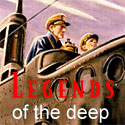 Had a conversation with a new member of the r/c sub community last week and it brought to mind the central issue for the newbie: what to build first?
Had a conversation with a new member of the r/c sub community last week and it brought to mind the central issue for the newbie: what to build first?Most of us are drawn to the hobby with visions of grandeur swimming in our heads. For me it was the ultimate fleet boat: 1/32 scale; fully detailed down to the last rivet; operational masts and radar; ten working torpedo tubes; diesel sounds when on the surface; running lights. I actually found a 32nd Parallel hull. It sat on my dining room table for a few weeks, hanging over each end by several feet, before it hit me -- I can't do this.
So many of my fellow skippers experienced the same crossroads starting out. The boat of their dreams was beyond their earthly means. What separated the ones who continue on in the hobby and those who don't? The "Beginner Sub."
The beginner sub is large enough to run in open water (Wal-Mart subs are toys). They come almost ready to run (Small World Model's boats), or in a highly prefabricated kit form (SubTech Albacore, Dumas Akula, ThorDesign Permit). Either way the box includes detailed instructions. Note that "beginner" doesn't mean "cheap." These are real r/c subs that stand up under use and perform like their real world counterparts. In most cases, Dumas Akula excluded, they are highly accurate scale models.
But why waste time building a boat you don't lay awake at night dreaming about? Simple. Instead of dreaming you will actually be driving, sooner rather than never. A beginner boat teaches you the things you don't yet know you need to know. Things like the fact that 5 minute epoxy isn't waterproof; how to install a WTC so that it sits level in the hull; setting up stern plane linkages around a prop shaft.
What the new guy can't know is that building the scale representation of a submarine is only one aspect of r/c submarining. You've also got to master submarine-specific electronics and how to keep them dry while in use. Trimming is an additional art that only comes through patient trial and error. The skill with which it is done means the difference between a pig of a boat or a sub that dances to your command. Because it takes skill to get r/c subs to run the way they were born to. Skill that can only be gained by stick time.
That's what beginner subs boil down to when laid alongside the jaw dropping museum pieces of our imaginations: they get completed in a reasonable amount of time and they run. They don't have to be perfectly within scale, they don't even have to look particularly pretty. They just need to be ready to run when the call comes down to go to the pond. Because r/c submarines are way more fun to drive than watch being driven.
And once your beginner sub is done you'll have plenty of time and space to tinker with your large scale Disney Nautilus project. They're what work benches are for.





0 comments:
Post a Comment